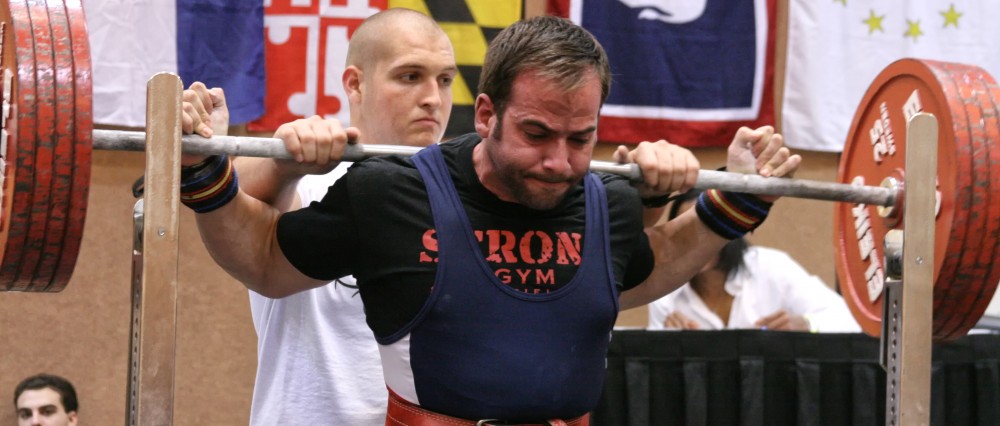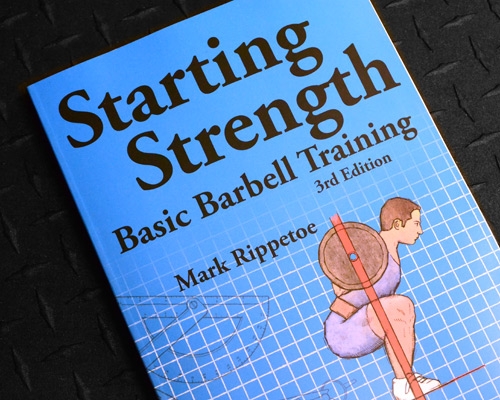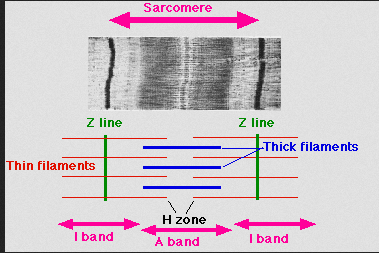By Jordan Feigenbaum MS, CSCS, HFS, USAW Club Coach, Starting Strength Staff
If you haven’t seen this article yet give it a read, as it should set the tone for this blog post. Just as an aside to those who disagree with this blog post or Mark’s article, save the ad hominem attacks and please present your analysis within the context of both anecdotal evidence and scientific evidence. If you’re going to use the latter, please make sure you read the entire study and look at the data before you make claims, as it will save everyone a lot of time and you some future embarrassment if you, ya know, missed something.
At any rate, I recently got hit with this statement and was asked for a response:
Quick question for you-my friend goes to Gold’s and one of the trainers there said it is “better to do cardio before weights”. I would love to get your opinion on the matter.
So instead of calling into question the validity of a trainer’s opinion who works at a Gold’s gym, which would be an ad hominem attack that doesn’t really address this statement, I thought I’d do this in a blog post about conditioning in general. I’m saving the heavily annotated discussion of this topic for my book and thus, this will merely be a reflection of what I believe the current science says and my experience in working with people as a coach.
To begin, we need to talk about what the goals of a training program, in general, actually are for an individual. In other words, WHY IS A PERSON TRAINING? If there is no clear-cut goal, I’d make the semantic argument that the person is just exercising for no particular reason, which is fine too. On the other hand, if a person does have a specific goal, yet is not taking specific steps to achieve this goal then the person’s training is, by definition, suboptimal. In short, we need to clarify what is the goal of the person we’re answering this question [When should I do conditioning?] in order to provide an accurate answer. Additionally, we need to get a clearer picture of what exactly the person is doing training or exercise wise depending on their current level of commitment to their goal. As you can see, there are lots of unknowns here that we can’t possibly answer and thus, the discussion needs to shift to be more general. So what we’ll do is go over the important considerations to determine optimal conditioning timing, frequency, etc. with respect to three general goals:
- Health
- Weight Loss
- Performance
Here’s the first question: How much conditioning* training is optimal? (cue explosions for dramatic affect)
* conditioning can be considered analogous to cardio (low intensity steady state-LISS, High intensity interval training (HIIT), circuits, etc.)
I’d make the argument that within the context of an individual who is following an intelligent training program that’s centered around planned progressive overload of the big lifts, e.g. the squat, bench, deadlift, press, power clean, and chin/pullup, that the optimal conditioning volume (total frequency and duration of conditioning efforts) should be the smallest amount needed to produce the desired goal. Let’s look at this from the health perspective first.
We know that training increases oxygen delivery to tissues, causes adaptations at both the tissue (macro) and cellular (micro) level, and alters hemodynamic properties (hemoglobin, blood viscosity, etc.) that all result in increased capacity to do work and sustain activity. The real question we should be asking from this perspective, however, is what sort of training most optimally reduces major negative health outcomes…ya know, like death, cancer, cardiovascular incidents, etc. Well, as it turns out the literature suggests that the stronger someone is, i.e. the more force they can produce with their muscles to move an external object, the lower the morbidity and mortality rates when compared to both sedentary populations and those who were more “aerobically developed” from doing typical conditioning/cardio training and, more interestingly perhaps, the same rates of morbidity and mortality as those who were the strongest and the most aerobically developed. As it turns out, there’s more than a nugget of truth on ol’ Rip’s adage:
“Stronger people are harder to kill than weaker people, and more useful in general”-Mark Rippetoe
Does this mean I’m saying people who are training/exercising for health purposes shouldn’t do any sort of conditioning? No, that’s not what I’m saying. I’m implying that you get a pretty decent stress from weight training to drive conditioning adaptations that have an observably profound effect on clinical outcomes. If you desire additional capacity for another purpose, i.e. you want to be able to run further/faster or have more “wind” when doing a particular activity (e.g. pick-up basketball), then doing some supplemental conditioning work will be useful in achieving these goals. However, let’s not be confused with what the literature is saying about how this will affect health.
This being said, if someone is not training in an intelligently implemented manner with a focus on the only incrementally loadable, systemically stressing modality there is, e.g. barbells, then he or she will need to do more conditioning work in order to supplement the lack of actual training stimulus he or she is getting from the gym. High intensity interval training (HIIT) is the obvious choice, as the adaptations and metabolic responses to this style of conditioning tend to mirror that of resistance training, whereas low intensity steady state cardio pales in comparison (though there is a purpose for this style training that we’ll discuss alter).
HIIT causes the skeletal muscles to move to relatively high velocities and contract with high forces compared to LISS. Because the demand for energy is so high during HIIT, it is appropriately referred to as anaerobic or glycolytic training, as the rate of energy production is so high that aerobic (with oxygen) energy producing pathways can’t keep up. When done appropriately, HIIT increases basal metabolic rate (BMR) significantly over many hours post exercise (more calories burned in total), increases mitochondria biogenesis (makes new energy producing and calorie burning power plants in the cell to increase BMR chronically), increases skeletal muscle’s uptake of nutrients (instead of fat), does not cause muscle catabolism (like LISS), and results in even more pronounced cardiorespiratory conditioning adaptations in the heart, lungs, and vascular tissues. HIIT works so well, clinicians are using it in COPD, MI, and Obese patient populations instead of LISS. Just sayin’…..
In sum, I don’t think there’s a good reason to do tons of conditioning work if you’re just interested in health UNLESS you need the extra conditioning work to produce other desirable changes, e.g. performance increases or fat loss.
So, how much conditioning is optimal for increasing performance? The answer (duh), is IT DEPENDS ON YOUR SPORT. If you’re a marathoner you’re obviously going to have a higher total conditioning volume than a weightlifter. Similarly, the types of conditioning are going to be different. Marathoners need steady state “tempo” work in order to develop efficiency in running, which is more strength and strength-endurance limited than it is limited by someone’s lungs/heart. In other words, you don’t stop running because you’re out of breath, you stop running because your legs are tired. This is a strength deficit, through and through, which is ameliorated by actually training to get strong AND doing longer runs to acclimate the body to become more efficient at running and therefore require less energy. If you’re a weightlifter, the only reason you’re doing conditioning is to improve your ability to lift weights, i.e. put pounds on the bar or improve recovery enough to increase training frequency (by being better conditioned) to aid in putting weight on the bar.
So the optimal amount of conditioning for a marathoner and a weightlifter are different, but the answer is still the same as what we covered in the health section, i.e the smallest amount needed to produce the desired goal. This will, of course, be different for everyone.
I bet you already know the answer to how much conditioning is optimal for weight loss (and you’d be correct): the smallest amount needed to produce the desired goal. Basically, we want to get the most out of the least so we have somewhere to go when we get stuck. Anyone who’s ever gotten really lean knows about getting stuck, which requires manipulation of conditioning efforts (usually adding more), training, and food intake (usually small reductions in carbs and fat). Unfortunately, people get greedy with results and think MORE IS BETTER, and cut out a bunch of energy (calories) and add a bunch of conditioning. Truth is, more isn’t better; BETTER IS BETTER.
By removing a bunch of calories when it’s not needed or, equivalently, adding a bunch of conditioning when it’s not needed you miss out on getting the best return on investment (ROI) possible and are, for no reason, reducing the amount of food you’re eating and increasing the amount of activity you’re doing. What do you think the body is going to do? It’s gonna say “Screw you guys I’m going home!”
Look, two things are happening here.
Thing 1: With calorie restriction, which is needed to lose weight, your metabolism slows down.
Thing 2: If your conditioning is mostly LISS, your metabolism slows down, i.e. you become more efficient at creating energy (no, this is not good). The current thinking on this mechanism has to do with reduced expression of uncoupling proteins in the mitochondria, which normally make the mitochondrial less efficient at creating energy (ATP).
So, imagine all the typical cardio bunnies starving themselves and doing hours of cardio on the elliptical; low intensity mind you because how are you supposed to read Elle magazine when you’re doing HIIT? Their metabolisms are slowing down from both ends and then boom, a big blowout weekend (or week) and what happens? Lots of fat deposition because their metabolisms are so depressed it’s the only thing that can happen. Yes Virginia, their BMR will increase transiently due to the “refeed” of a hypercaloric couple of days, but lots of adipose tissue will also get stored.
So, in short….how much conditioning should you do? The smallest amount needed to produce the desired goal.
The next question is rather obvious, what is the purpose of conditioning?
From a health perspective, there’s really not a lot of purpose for pure conditioning modalities unless it’s either facilitating another related (e.g. fat loss) or unrelated goal (e.g. more conditioning for sport) OR the person isn’t training and therefore needs something to supplement them.
From a performance standpoint, the purpose of conditioning is to drive the adaptations specific to that sport. Returning to the marathoner vs. weightlifter, the marathoner is obviously going to spend more time doing steady state stuff and their interval work will have different work to rest ratios (1:1-1:3 will be the bulk of it) versus the weightlifter not doing hardly any steady state stuff and sticking to interval work with 1:5-1:20 work to rest ratios. The only exception to the “drive the adaptations specific to that sport” mantra is if the sport is a weight class sport and thus the conditioning’s purpose may also include fat loss/weight manipulation
From a weight loss perspective, the purpose of conditioning is fat loss pure and simple. HIIT trumps LISS in this regard, as even though a longer LISS session certainly burns more calories during the activity, the HIIT burns more calories in total than the LISS by increasing resting metabolism over the course of hours-days post workout. People will say “Well you burn a higher percentage of fat doing LISS than HIIT”, which is true. On the other hand, I don’t really care about the percentage of fat I burn, I care about the total number of fat I burn, which is much greater in HIIT since the total energy expenditure is much higher. Kind of a dumb argument if you ask me.
The final question, which is the original motivation for even writing this things is: When should you optimally do conditioning?
Now, there’s really no reason to discuss the health perspective on this since the only reason to do conditioning for health is in order to increase performance or improve fat loss so we’ll stick with those.
Performance-wise, this all depends what kind of athlete you are. If you’re in a sport that’s conditioning focused then there will likely be plenty of times you’re going to be doing conditioning only during practice or programmed sessions. I could make the argument that if there are skills you need to practice that these should be incorporated first before the conditioning work, as it is highly fatiguing and might interfere with practicing optimal technique of the skill. This is the same for strength/power training, i.e. it should come first for virtually any athlete who’s going to train multiple modalities in the same day even if he or she is going to split them up into multiple training sessions in the course of the day (i.e. 2 or 3-a days). Will doing a heavy squat session first or in the AM negatively impact the ability to do a long tempo run second or in the PM? Of course, duh. However, the squat session is going to have less of an effect on the run as the run would have on the squat. Moreover, the runner is going to get a more useful stimulus from the squats than the run provided the context we’re discussing is the off season or GPP/accumulation phases. On the other hand, I could make the argument that during more specific training phases or in-season cycles, the runner should run first and then do a lighter, more attenuated squat session later to try and preserve strength during the season. Applying this same rationale to a weightlifter and the answer becomes crystal clear, conditioning comes after the weights 100% of the time with respect to developing performance.
When talking optimal conditioning timing concerning weight loss, the answer is really even clearer in my opinion. Optimally, you’d do conditioning (HIIT mostly) on your OFF days, i.e. days you’re not training with weights. See, resistance training provides a super potent stimulus to the body to increase metabolism, burn calories for hours post workout, partition nutrients favorably, and otherwise adapt to the stress imparted upon it. Adding conditioning workouts to a resistance training session, therefore, is not optimal in that you’re already getting a big time stimulus from training anyway and there’s MORE benefit to be had by doing it on your off days where you where previously receiving no stimulus (or a waning stimulus from the previous day’s training). Remember, the goal here is to signal as much possible increase in BMR, favorable nutrient partitioning, and net calorie burn as possible.
Understandably, many people do not have a flexible enough schedule to do this and so the crux of the matter becomes this: Should I do cardio before or after weights? Answer (you probably already know this): AFTER!!!!
Resistance training provides a more potent stimulus than conditioning, period. Why? Because resistance training is heavier, has longer ranges of motion, and overall imparts more stress on the human organism (or at least it should). If you did conditioning before training, you’re fatiguing motor units, depleting the muscles of energy, and overall reducing possible intensity, volume, etc. that could possible be attained in the session as a whole. Now, weight training first will certainly attenuate the amount of intensity or effort a person can put into conditioning but this is not as severe as the opposite since, ya know, conditioning is easier than burying a heavy squat.
My stock recommendation for those who have to get in and out of the gym in an hour and can’t train more than 3-4x a week is as follows: Spend 45 minutes doing progressively heavier barbell training and 15 minutes doing HIIT everytime. Period.
-thefitcoach








